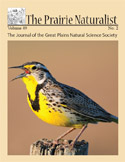Great Plains Natural Science Society

The Prairie Naturalist
Resource Selection of Greater Prairie-Chicken and Sharp-Tailed Grouse Broods in Central South Dakota
Date of this Version
12-2010
Document Type
Article
Citation
The Prairie Naturalist· 42(3/4): December 2010, pp 100-108
Abstract
Habitat use of sympatric greater prairie-chicken (Tympanuchus cupido) and sharp-tailed grouse (T. phasianellus) broods during the brood-rearing season has not been quantified for stable prairie grouse populations in large contiguous grassland landscapes in the Northern Great Plains. Characteristics of habitats used by prairie grouse broods were described based on data collected from 35 broods (18 greater prairie-chicken and 17 sharp-tailed grottse) during the breeding seasons of 2004 and 2005. Greater prairie-chicken and sharp-tailed grouse broods used vegetation with visual obstruction heights 2:26 cm and 37 cm, respectively. Greater prairie-chicken broods selected western wheatgrass (Pascopyrum smithii), green needlegrass (Nassella viridula) and Japanese brome (Bromus japonicus) dominated habitats. Sharp-tailed grouse broods selected sweet clover (Melilotus ~spp.), mixed forb-dominated vegetation, and green needlegrass dominated habitats. Both grouse species avoided habitats dominated by smooth brome (B. inermis). Knowledge of brood habitat use will provide information on suitable brood habitat resources needed to sustain prairie grouse populations in South Dakota.
Included in
Biodiversity Commons, Botany Commons, Ecology and Evolutionary Biology Commons, Natural Resources and Conservation Commons, Systems Biology Commons, Weed Science Commons

